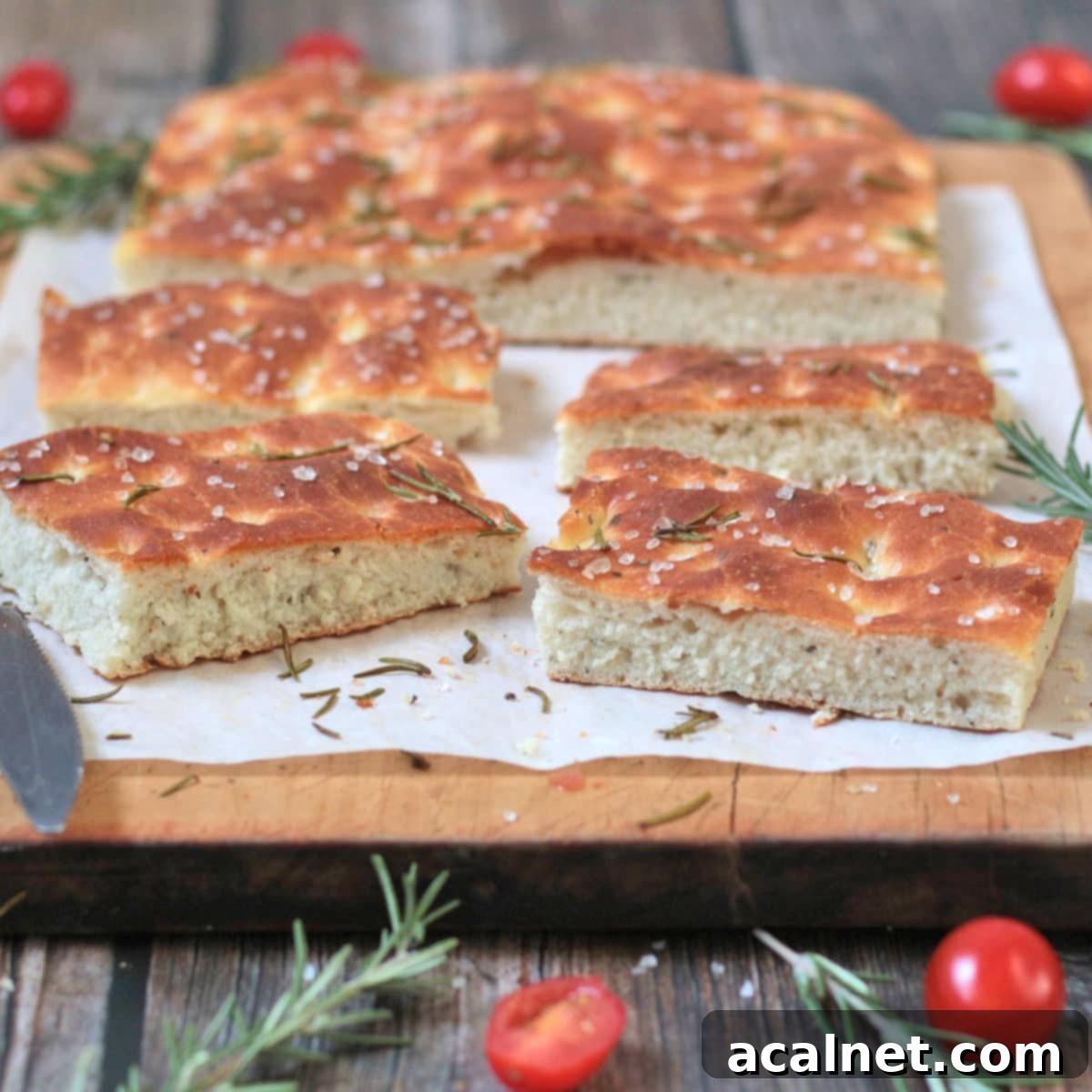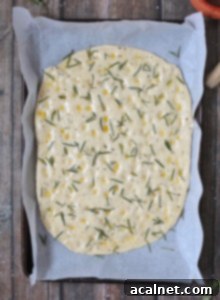The Ultimate Easy Rosemary Focaccia Bread Recipe: Authentic Italian Flavor at Home
This super easy Focaccia Bread recipe is a fantastic choice for any occasion, serving as a delightful party appetizer or transforming into a satisfying dinner when paired with your favorite toppings. Get ready to embark on a baking journey that brings the authentic taste of Italy right to your kitchen!
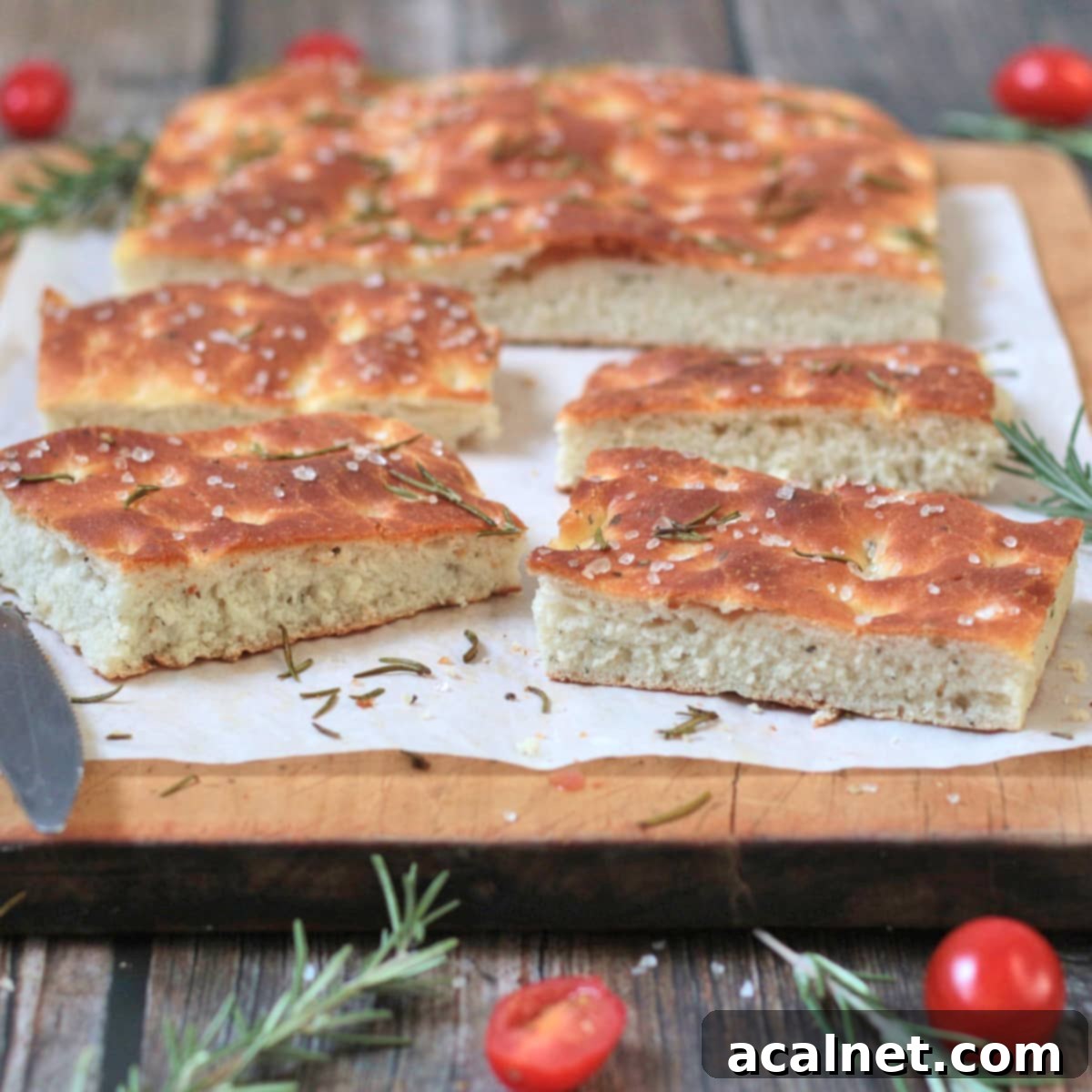
What is Focaccia Bread? Unveiling Italy’s Beloved Flatbread
Focaccia is more than just a bread; it’s a staple of Italian cuisine, a traditional yeast-based flatbread enriched generously with olive oil. Originating from Liguria, a coastal region in northwest Italy, focaccia’s roots can be traced back to ancient times, even to the Roman Empire where it was known as “panis focacius,” meaning “hearth bread.”
Distinguishable by its characteristic dimpled surface, which is poked throughout the dough before baking, focaccia boasts a beautiful golden-brown, often crispy crust and a soft, airy, and chewy interior. The abundant use of extra virgin olive oil not only gives it its distinct rich flavor but also contributes to its wonderfully tender texture.
While many regional variations exist across Italy, the Rosemary Focaccia, seasoned with fresh rosemary and coarse sea salt, is arguably the most recognized and beloved version outside of Italy. Its aromatic fragrance and savory taste make it an irresistible treat.
Focaccia dough shares similarities with pizza dough in both texture and taste, often making it a versatile base for various toppings. Like its cousin, the Ciabatta, another beloved Italian bread, focaccia is delicious on its own, perfect for soaking up olive oil or accompanying a meal, but truly shines when adorned with a creative array of ingredients.
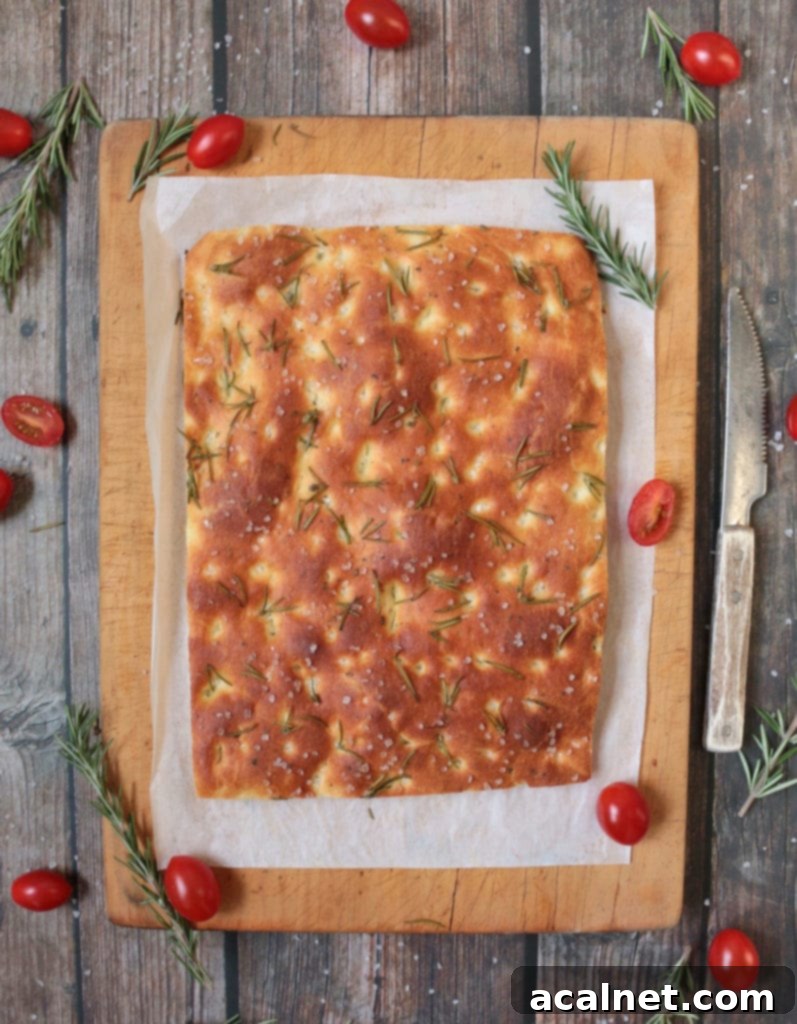
Why You Should Bake Focaccia at Home
There’s something incredibly rewarding about baking bread from scratch, and focaccia is no exception. Here are just a few reasons why you should try this easy homemade focaccia recipe:
- Unbeatable Freshness: The aroma of freshly baked focaccia filling your kitchen is simply divine. Nothing beats the taste and texture of bread straight from the oven.
- Control Over Ingredients: Making it yourself means you know exactly what goes into your bread. You can choose high-quality olive oil, fresh herbs, and organic flour if you wish.
- Customization Galore: While rosemary and sea salt are classic, homemade focaccia offers endless possibilities for toppings. From olives and cherry tomatoes to caramelized onions and cheese, your creativity is the only limit.
- Impress Your Guests: Focaccia makes a stunning centerpiece for any gathering. Its rustic beauty and delectable taste are sure to earn you compliments.
- It’s Easier Than You Think: Don’t be intimidated by yeast bread. This recipe is designed to be straightforward and forgiving, making it perfect for novice bakers and experienced cooks alike.
Essential Ingredients for Rosemary Focaccia
Creating a truly delicious Rosemary Focaccia starts with a few simple, high-quality ingredients. For the **Focaccia Bread Dough**, you will need:
- Lukewarm Water: Crucial for activating the yeast. Ensure it’s not too hot (which kills the yeast) or too cold (which won’t activate it). Around 105-115°F (40-46°C) is ideal.
- Instant Yeast Powder: This type of yeast can be mixed directly with dry ingredients, but we’ll activate it first to ensure it’s active and vibrant.
- Caster Sugar: A small amount of sugar acts as food for the yeast, helping it to activate and grow, contributing to a better rise and a hint of sweetness.
- Plain, All-Purpose Flour: While all-purpose flour works well, for an even chewier and more authentic texture, consider using bread flour, which has a higher protein content.
- Table Salt: Essential for flavor and to regulate yeast activity.
- Extra Virgin Olive Oil: This is a star ingredient! Use a good quality extra virgin olive oil, as its flavor will deeply infuse the bread. It provides moisture, richness, and that characteristic Italian taste.
- Optional: Ground Rosemary or Italian Seasoning: For an extra layer of herbal flavor within the dough itself.
After the dough has risen and is ready for baking, a few more ingredients are added to the flatten dough to complete the classic Rosemary Focaccia:
- A little bit more Extra Virgin Olive Oil: Brushed over the top before baking, it creates a beautiful golden crust and prevents drying.
- Fresh Rosemary: Sprinkling fresh rosemary leaves on top adds an intense aromatic burst that defines classic focaccia.
- Sea Salt: Coarse sea salt crystals provide a delightful crunch and a burst of savory flavor with every bite.
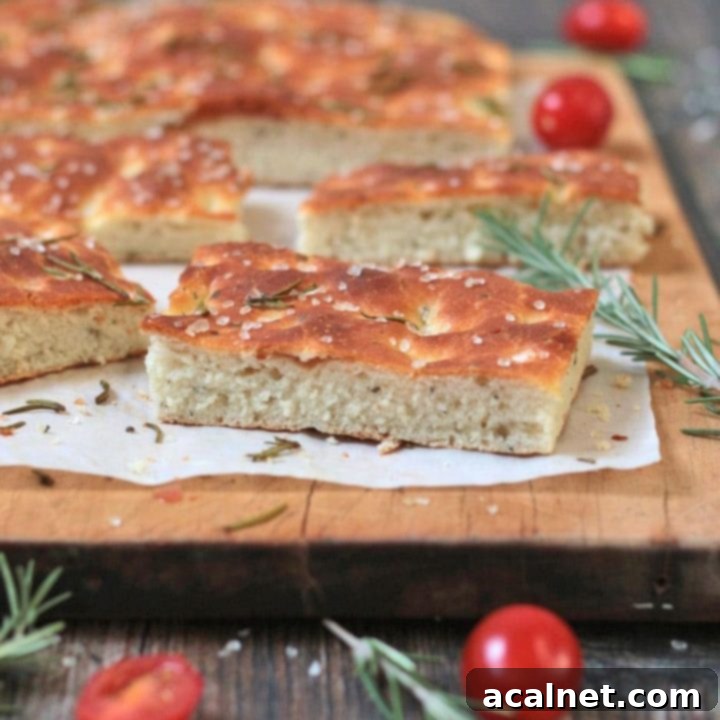
Step-by-Step Guide: How to Master Homemade Focaccia
Making focaccia bread is surprisingly similar to making any other yeast bread, with the delightful addition of generous amounts of high-quality olive oil, which contributes to its unique texture and flavor. Follow these simple steps for a truly authentic and delicious Italian flatbread:
- Activate the Yeast: In a small bowl, combine the lukewarm Water, Instant Yeast Powder, and Caster Sugar. Give it a gentle whisk to combine. Let this mixture sit for 5 to 10 minutes. You’ll know the yeast is active and healthy when the top becomes bubbly and foamy. This step is crucial as it ensures your bread will rise properly.
- Mix the Dough: In the bowl of a stand mixer fitted with a dough hook (or a large mixing bowl if kneading by hand), add the Plain Flour, Table Salt, and the optional Ground Rosemary or Italian Seasoning. Pour the activated yeast mixture and the Extra Virgin Olive Oil over the dry ingredients.
- Knead to Perfection: Begin kneading on a low to medium speed for about 5 minutes. The dough should gradually come together, becoming smooth and elastic. If it still appears shaggy, sticky, or breaks apart easily, continue kneading for another couple of minutes until it forms a cohesive, pliable, and smooth ball. If kneading by hand, work the dough on a lightly floured surface until it passes the “windowpane test” (you can stretch a small piece thin enough to see light through it without tearing).
- First Rise (Proving): Once kneaded, place the dough in a lightly oiled bowl, turning it once to coat. Cover the bowl tightly with a clean tea towel or plastic wrap and leave it in a warm place to prove for 45 minutes to 1 hour, or until it has visibly doubled in size. A warm, draft-free spot is ideal for this process.
- Prepare for Baking: While your dough is proving, preheat your oven to 180°C (350°F). Line a large sheet pan with baking paper or a silicone baking mat. This prevents sticking and makes cleanup easier.
- Shape and Flatten: Gently punch the air out of the risen dough (this is oddly satisfying!). Transfer the dough onto a lightly floured surface. Using your fingers or a rolling pin, gently flatten and spread the dough into a large rectangle, aiming for a thickness of about 1/2 to 3/4 inch (1.5-2 cm). Try to match the size of your prepared sheet pan. Be careful not to spread it too thinly, as focaccia should have a nice, substantial chew.
- Dimple and Top: Carefully transfer the flattened dough onto the prepared baking tray. Using your fingertips, poke small indentations (dimples) all over the surface of the dough. You can poke them quite deeply, but be mindful not to tear through to the bottom. These dimples are characteristic of focaccia and help to hold the olive oil and toppings.
- Final Touches and Bake: Generously brush the remaining Extra Virgin Olive Oil over the entire surface of the dimpled dough. Then, sprinkle the Sea Salt and fresh Rosemary leaves evenly over the top. Place the sheet pan in the preheated oven and bake for 15 to 20 minutes, or until the focaccia is beautifully golden brown on top and cooked through.
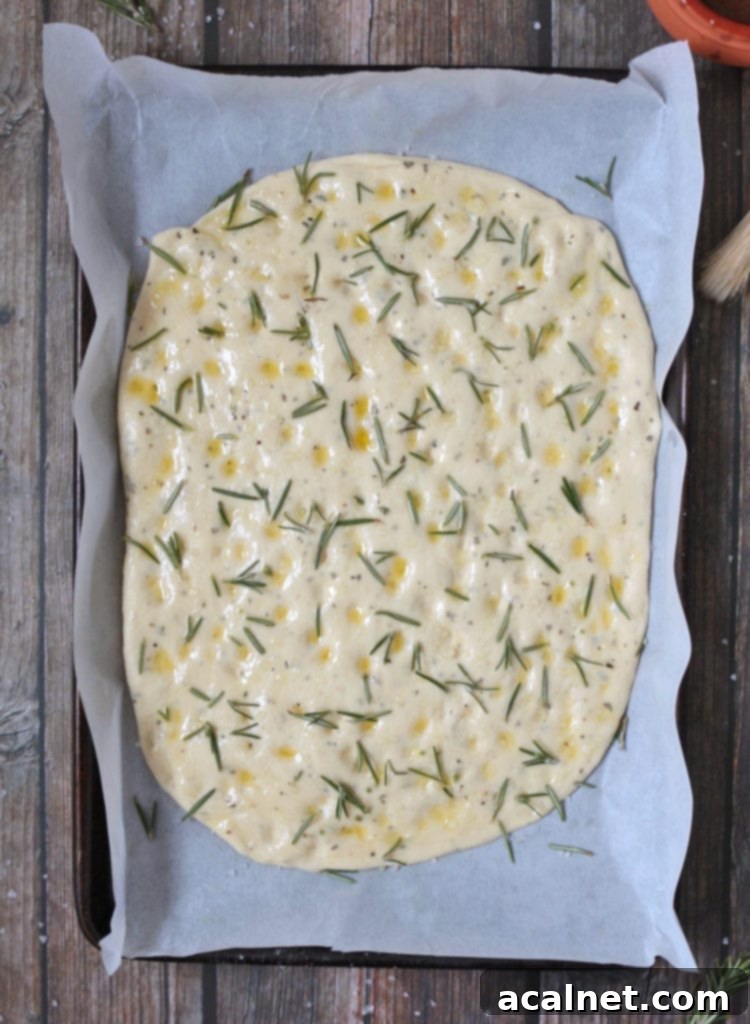
Creative Focaccia Topping Ideas for Every Occasion
While the classic Rosemary and Sea Salt Focaccia is absolutely delicious on its own, making a great party appetizer or a simple accompaniment to any meal, its versatility truly shines when you explore different topping ideas. Think of focaccia as a blank canvas for culinary creativity!
To elevate your focaccia into a hearty meal, consider layering it with a variety of condiments, fresh vegetables, marinated foods, or cured meats. Mediterranean-inspired ingredients like sun-dried tomatoes, olives, and fresh herbs always pair wonderfully with the rich flavor of olive oil and the chewy bread texture.
Here are some creative and mouth-watering topping ideas to inspire your next focaccia creation:
- Classic & Simple: Beyond rosemary and sea salt, a drizzle of high-quality balsamic glaze after baking can add a touch of sweet acidity.
- Potato & Rosemary: Thinly sliced Potatoes (par-cooked slightly, or very thinly sliced raw) and fresh Rosemary, baked until the potatoes are tender and golden.
- Cherry Tomato & Basil: Halved Cherry Tomatoes pressed into the dimples, with fresh Basil leaves added after baking for vibrant flavor.
- Olive & Garlic: A generous scattering of pitted Olives (Kalamata, Castelvetrano, or a mix) and thinly sliced fresh Garlic.
- Anchovy & Caper: For a bold, savory flavor, layer with small Anchovy fillets and briny Capers.
- Pizza Style Focaccia: Transform it into a focaccia pizza! Spread with a light layer of homemade Tomato Sauce and sprinkle with shredded Mozzarella or burrata.
- Marinated Vegetables: Top with tender, marinated vegetables such as roasted Mushrooms, artichoke hearts, grilled Capsicum (bell peppers), or thinly sliced grilled Eggplant.
- Italian Cured Meats: Serve slices alongside delicate slices of an Italian Cured Meat like Prosciutto, Bresaola, or Mortadella, added just before serving.
- Caramelized Onion & Thyme: Sweet and savory caramelized onions with fresh thyme create a deeply flavorful topping.
- Pesto & Pine Nuts: Swirl pesto over the dough before baking and sprinkle with toasted pine nuts for a rich, aromatic experience.
Whether you’re serving it as an appetizer with olive oil for dipping, as a side with soup or salad, or as the base for a hearty sandwich, focaccia is incredibly adaptable and always a crowd-pleaser.
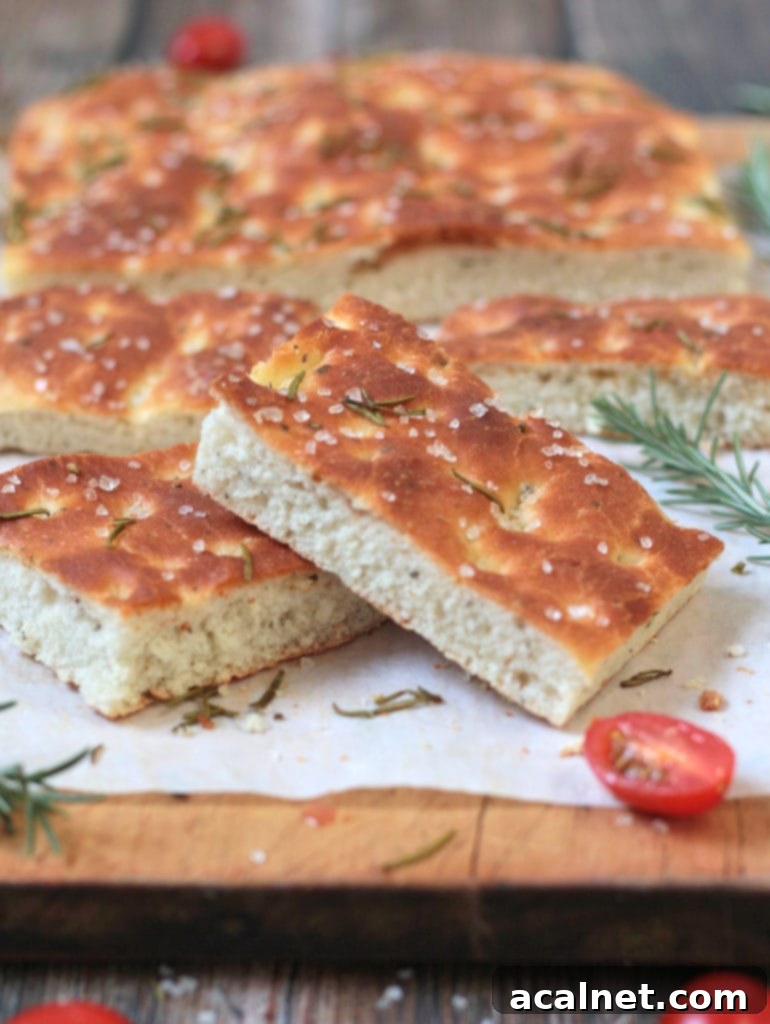
Tips for a Flawless Focaccia Every Time
Even though focaccia is considered an “easy” bread to make, a few expert tips can ensure your homemade version turns out absolutely perfect, with that ideal airy crumb and crispy crust:
- Quality Olive Oil is Key: Since olive oil is such a prominent flavor, invest in a good quality extra virgin olive oil. It makes a significant difference in taste and aroma. Don’t be shy with it – both in the dough and brushed on top.
- Don’t Rush the Proofing: Yeast needs time to work its magic. Ensure your dough doubles in size during the first rise. If your kitchen is cool, find a warmer spot, like near a sunny window or in a slightly warm (but turned off) oven. A slow rise often yields better flavor.
- Hydration Matters: Focaccia dough is typically quite wet and sticky. Resist the urge to add too much extra flour during kneading or shaping, as this can result in a dense, dry bread. A little stickiness is good!
- Gentle Handling: Once the dough has risen, handle it gently to preserve the air bubbles that contribute to its light and airy texture. Punching down vigorously can expel too much air.
- Proper Dimpling: The dimples are not just for aesthetics; they create pockets for the olive oil and prevent large air bubbles from forming, which can make the bread puff up unevenly. Press your fingers firmly but not so hard that you tear the dough.
- Hot Oven, Quick Bake: Focaccia bakes relatively quickly in a hot oven. This helps achieve that crispy exterior while keeping the interior soft. Keep an eye on it to prevent over-baking, which can dry it out.
- Cool Slightly Before Slicing: While it’s tempting to dive in immediately, letting the focaccia cool for a few minutes after baking allows the internal structure to set, resulting in better texture when sliced.
Storing and Reheating Your Homemade Focaccia
Homemade focaccia is always best enjoyed fresh and warm, but if you happen to have leftovers, here’s how to keep them delicious:
- Storage: Once completely cooled, store focaccia in an airtight container or wrap it tightly in plastic wrap at room temperature for up to 2-3 days. To maintain its best texture, avoid refrigerating it, as bread tends to dry out quickly in the fridge.
- Freezing: Focaccia freezes beautifully! Wrap individual slices or the whole loaf tightly in plastic wrap, then again in aluminum foil. It can be frozen for up to 2-3 months. Thaw at room temperature before reheating.
- Reheating: To bring focaccia back to life, preheat your oven to 180°C (350°F). Sprinkle a little water on the surface (optional, helps restore moisture) and warm for 5-10 minutes until heated through and the crust is slightly crispy again. You can also lightly toast slices in a toaster oven. Avoid microwaving, as this can make it chewy.
More Delicious Homemade Bread Recipes
If you’ve enjoyed baking this focaccia, you might be inspired to try more homemade bread recipes. Here are some other fantastic bakes to explore on your culinary journey:
- Cinnamon Scrolls from Scratch
- Easy Lemon Sweet Rolls
- Chocolate Brioche Bread Wreath
- Apple Cinnamon Pull Apart Bread
- Chocolate Raspberry Buns
- Spinach and Ricotta Rolls
- Sweet Potato Buns
- No Knead Bread
Made this recipe?
Let us know if you liked it by leaving a comment below, and tag us on Instagram @a.baking.journey with a photo of your creation!
Recipe
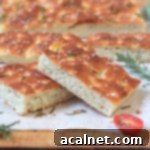
Rosemary Focaccia Bread
12 small slices
Sylvie
20 mins
20 mins
1 hr
1 hr 40 mins
Print Recipe
Ingredients
Focaccia Bread
- 2/3 cup (150ml) Lukewarm Water
- 3 teasp. (10 gr) Instant Yeast Powder
- 1 tbsp (12 gr) Caster Sugar
- 1 1/3 cup (250 gr) All-Purpose Flour
- 1 teasp. (6gr) Table Salt
- 1 tbsp (15 ml) Extra Virgin Olive Oil
- 1 teasp. Ground Rosemary or Italian Seasoning (optional)
Toppings
- 1 to 2 tbsp (15 to 30 ml) Extra Virgin Olive Oil
- Sea Salt – to taste
- Fresh Rosemary Leaves – to taste
Instructions
Focaccia Bread
- Combine the Warm Water, Caster Sugar and Instant Yeast Powder in a small bowl. Whisk together then leave for 5 to 10 minutes – the top of the liquid should be bubbly/foamy.
- Place the All Purpose Flour, Ground Rosemary (optional) and Table Salt in the bowl of your mixer. Make a well and pour in the Water/Yeast liquid as well as the Olive Oil.
- With a dough hook, knead for about 5 minutes, slowly increasing the speed to medium. The dough should be completely smooth and elastic. If it is still breaking apart or does not look smooth and elastic, knead for another couple of minutes.
- Cover with a tea towel and place in a warm place to prove for about an hour, or until the focaccia dough has doubled in size.
- Preheat your oven on 180’C / 350’F. Line a large sheet pan with baking paper or baking mat.
- Remove the tea towel from the bowl and punch the air out of the dough, then transfer on a lightly floured surface. Use your fingers or a rolling pin to spread the dough into a large rectangle, about the size of your sheet pan. Try not to spread the dough too thinly.
- Place the flatten dough onto the sheet pan. Carefully poke the dough with your fingers to create small holes (you can poke it quite deeply but be careful not to cut trough the entire dough).

Toppings
- Brush the olive oil over the flattened bread, then sprinkle the Sea Salt and Rosemary leaves. Bake for 15 to 20 minutes or until golden brown.
- Serve warm as is or with your choice of extra toppings.
Nutrition (per serving)
Carbohydrates: 14g |
Protein: 3g |
Fat: 3g |
Saturated Fat: 1g |
Sodium: 196mg |
Potassium: 45mg |
Fiber: 1g |
Sugar: 1g |
Calcium: 4mg |
Iron: 1mg
